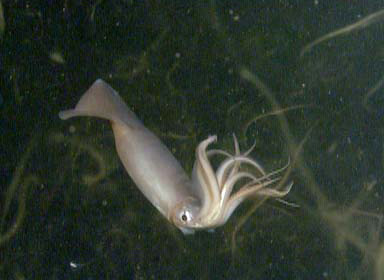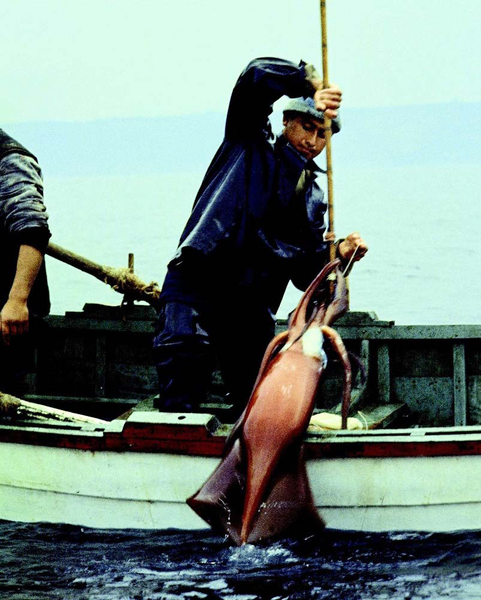
Interactions
The majestic Dosidicus gigas is a vital animal for both its
marine ecosystem as well as the economy. It plays a major role as a
predator and prey for organisms ranging from lanternfish to humans.
Prey Interaction- The Humboldt squid hunts a variety of marine life
including shrimp, sardines and lanternfish. They truly are
opportunistic when it comes to hunting. Whatever food the Red Devil
can use its powerful tentacles and ferocious beak to tear apart, it
will certainly do so. It comes as no surprise that they are also
prey to themselves. Some studies from the Gilly Lab at Stanford
University show that a significant part of their diet consists of
other Humboldt squid. However, they will mostly prey upon smaller
organisms that are easier to catch and eat (Markaida and
Sosa-Nishizaki, 2003).
sardines and lanternfish. They truly are
opportunistic when it comes to hunting. Whatever food the Red Devil
can use its powerful tentacles and ferocious beak to tear apart, it
will certainly do so. It comes as no surprise that they are also
prey to themselves. Some studies from the Gilly Lab at Stanford
University show that a significant part of their diet consists of
other Humboldt squid. However, they will mostly prey upon smaller
organisms that are easier to catch and eat (Markaida and
Sosa-Nishizaki, 2003).
Predator Interaction- Although Dosidicus gigas is a frightening hunter, they are by no means the absolute top of the food chain. Several other animals hunt and eat Humboldt squid. These fearsome predators include a variety of sharks, dolphins, larger tunas , sperm whales and other sizable fishes and mammals (Field et al., 2007). The Humboldt uses its arsenal of hooked tentacles, sharp beak, and ink sac to deter attackers. It can also swim over the water at speeds up to 15 mph and even jet itself out of the water in order to avoid predators. This animal is not called “Red Devil” for nothing; it takes a very formidable killer to take down a Humboldt Squid.
Human Interactions- Humans catch hundreds of thousands of
Humboldt squid every year and they are an increasingly large part of
the economic market (Field et al, 2007). Every night on the West
coast many fishermen head out to fish for Humboldt squid. The catch
is profitable and considered a Japanese delicacy; however it is not
easy. Each Jumbo squid must be caught by hand line while they are
hunting in the shallows as we see in this
video. It is common for a squid to squirt large
amounts of water and ink at their human attackers once above the
water. Besides this huge amount of squirting liquid, the Humboldts
are also notoriously aggressive and have long, muscular tentacles
whipping about the fishing vessel.
and they are an increasingly large part of
the economic market (Field et al, 2007). Every night on the West
coast many fishermen head out to fish for Humboldt squid. The catch
is profitable and considered a Japanese delicacy; however it is not
easy. Each Jumbo squid must be caught by hand line while they are
hunting in the shallows as we see in this
video. It is common for a squid to squirt large
amounts of water and ink at their human attackers once above the
water. Besides this huge amount of squirting liquid, the Humboldts
are also notoriously aggressive and have long, muscular tentacles
whipping about the fishing vessel.
There are several stories about fishermen being dragged down to the depths of oceans by these marine beasts. These stories are a main reason why Mexican fishermen call them “Diablo Rojo”. News stories like the one from The Telegraph portray Dosidicus gigas as an aggressive large-bodied hunter that has been known to attack divers off the coast of San Diego. Attacks by D. gigas are rare but can happen, they are vicious and fearsome creatures when feeling stressed.
Parasitic Interactions- Along with an abundance of other organisms, the Humboldt squid can play host to several types of parasites. In a studies done specifically to find the variety of parasites on Dosidicus gigas, 9-12 different species of nematode, cestode, trematode and the ciliate Chromidina were found (Nimatullin et al. 2001). However, most of the parasites found were in the larval stage, which made for complicated detection. These parasites harmed the Humboldt squid by literally stealing the nutrients out of its body.